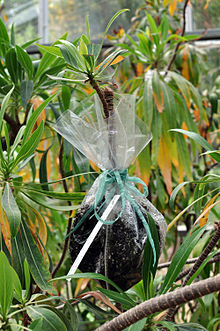Mossing

The Abmoosen is a technique in horticulture for vegetative propagation of plants, especially woody plants.
The aim of mossing is to encourage the part of the plant to be mossed to form roots, even though it is not in the ground. There are different methods for this:
Wedge method
A shoot of the plant is partially cut across, the gap is kept open with a wedge. If necessary, the cut surface is dusted with rooting hormone powder and then wrapped in an absorbent material such as peat moss or cellulose cloth, which must always be kept slightly moist for several weeks. After the roots have developed, the shoot is finally cut off and planted.
Ring method
The bark is removed in a 2–4 cm wide strip, in some tree species significantly more (oak: 10 cm), by making two appropriately spaced cuts around the part of the plant to be mossed down to the sapwood / cambium and peeling off the bark in between .
As a result, water still reaches the overlying part of the plant, as it is transported in the sapwood, while the photosynthesis products can no longer be transported to the roots, as the required bark is missing. The plant tries to replace the roots that can no longer be reached and to form new roots at the upper edge of the barkless strip. In order to stimulate this, a damp coat is placed around the bark-free ring, for example made of sphagnum moss, peat or mineral substrates such as pumice, lava, zeolite or moistened dry fill (expanded clay). In order to maintain the moisture, the jacket is tightly enclosed with plastic film, or it is regularly poured or moistened.
Depending on the type of plant , roots form in the moistened coat after some time, usually two to five months, in the case of conifers it may take two years. Now the part of the plant to be mossed can be cut off just below the newly formed roots, so that an independent new plant results. If the bark strip is too narrow, the plant will overwhelm the removed bark instead of forming roots, thereby ensuring the transport of nutrients to the (old) roots. In this case the mossing would have failed and would have to be repeated with a wider ring.
The ring method is the more promising of both variants and results in a partial plant that is rooted all around, while the wedge method is only able to produce roots in one place.
features
Advantages of mossing over cuttings are:
- Some plants cannot be propagated by cuttings at all, as they depend on a supply of nutrients from the mother plant during the rooting phase.
- Mossing is also possible on relatively thick, woody stems, so that large young plants emerge. The method is therefore suitable for the rejuvenation of old plants, e.g. B. the rubber tree .
- There is hardly any stagnation in growth on the cutting.
The disadvantage of mossing compared to cuttings is: This process is relatively complex, which is why it is practically not used in professional large-scale horticulture, but actually only in the hobby area, e.g. B. as a design measure for bonsai . In order to reproduce larger quantities, the specialist can use technical aids such as spray mist systems to root almost every cutting.
Previous meaning
In the older literature on horticulture, mossing means the removal of moss from the tree bark, since the moss was considered harmful to the tree.
literature
- Jan Ahrens et al .: “ Expertise for florists. Botany, flower care, design, business customers, management. “5th edition. Bildungsverlag EINS, Troisdorf 2006. ISBN 3-8242-2173-X .
Web links
Individual evidence
- ↑ Ahrens (2006), pp. 85f.
- ↑ Ahrens (2006), p. 85
- ↑ LF Dietrich: “ Encyclopedia of the entire lower and higher garden art. A detailed presentation of fruit, vegetable, flower and landscape gardening, viticulture and forcing in all their forms, based on the latest experiences, along with instructions on the buildings and equipment used in the various branches of gardening, a description of the life of those around horticulture and botany earned men explanation of botanical classification, declaration of occurring in the Horticultur foreign and German technical terms, as the usual abbreviations, instructions for holding or destroying of harmful animals, etc. " Arnoldische bookstore. Leipzig 1860. S. 5, Lemma: peeling off
